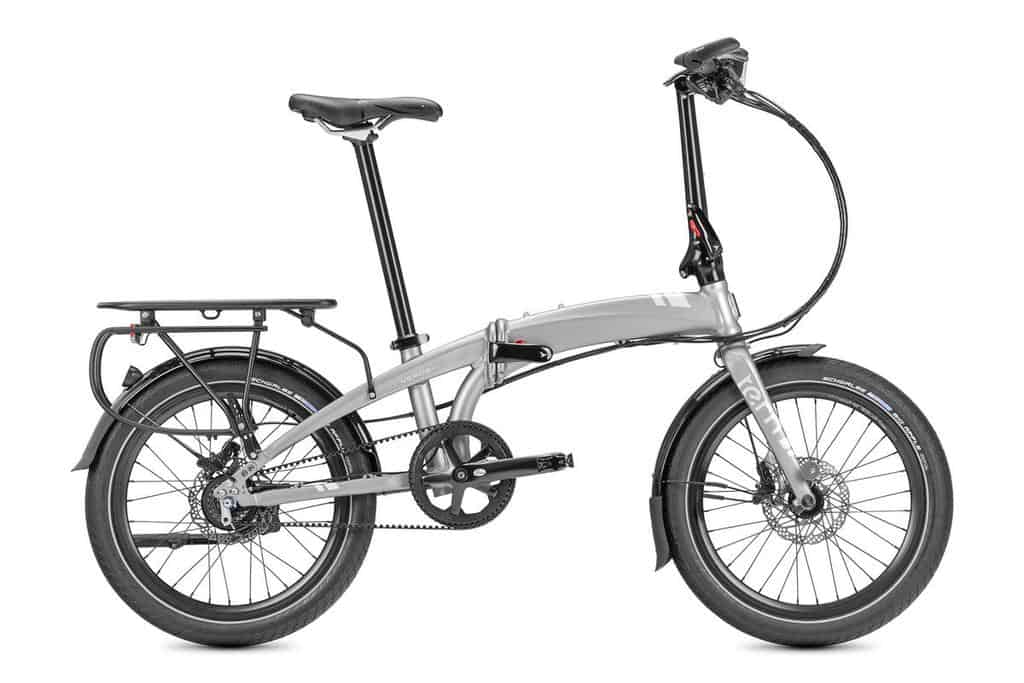Last updated: July 17th, 2023
Tern is one of the most popular folding bike brands on the market. You’ll see them in almost every corner of the world.
They make a wide range of folding bikes, with something for just about every combination of needs and budgets.
Let’s take a closer look at the brand, its offerings, and what a prospective buyer needs to know.
This article might contain affiliate links. As a member of programs including Amazon Associates, I earn from qualifying purchases.
Here’s what makes Tern bikes good
Tern makes excellent folding bikes for practical and recreational use. Most are mid- to high-end models with thoughtful drivetrain and brake upgrades that frequent riders will appreciate. Some Tern models have innovative, proprietary designs that fit extra cargo capacity or uncommonly large wheels into a folding bike.
They’ve also branched out of the folding bike niche and continue to come up with immensely practical models, like the compact HSD and GSD mini cargo e-bikes.
A small but nice feature on certain Tern models (like the relatively new BYB is the head-tube luggage mount. A standard front basket attaches to the fork/axle/handlebars, which means it turns and sways as you ride.
The head-tube mount fixes it to the bike frame itself, which is stationary. That means the cargo/luggage weight won’t affect how the bike handles. (Brompton is one of the very few other folding bike brands that offer this.)

Who owns Tern?
Tern is an independent brand that belongs to a holding company called Mobility Holdings.
It’s often assumed that Tern is part of Dahon, but that’s incorrect. They are distinct companies run by distinct people.
Tern was founded in 2011 by Joshua Hon, who is the son of David Hon, founder of—you guess it—Dahon. Unfortunately, it seems family relations were tense. Litigation between the two companies began in late 2012, and was resolved about six months later in April, 2013.
Despite their family connection, Tern and Dahon are separate companies. Dahon has generally prioritized straightforward entry- and mid-range folding bikes. Tern, on the other hand, has a more experimental streak and has not shied away from high price points, especially in the e-bike market.
Tern is perhaps more inventive than Dahon, with a more “premium” perception, but neither brand is definitively better. Both are good values and reputable manufacturers in their respective price points.
Where are Tern bicycles made?
Tern is headquartered in Taipei, Taiwan and has used multiple factories in Taiwan and mainland China. They may have used other locations, too, but details are not publicly available.
Components come from several companies, each with their own supply chains, so Tern bikes don’t completely come from any one place. That’s how virtually all bicycle brands operate today.
How much are Tern bikes?
As of 2021, Tern’s non-electric folding bikes range from about $549 to $2,699 MSRP. Most of them are between $1,000 and $2,000.
Tern’s electric models start at $3,499 and run as high as $8,999 for the top of the line. Those prices are in keeping with other high-end electric cargo bikes. Although they’re expensive, they have the cargo capacity and reliability to replace a small car for most daily needs.
Why are Tern bikes so expensive?
Tern’s entry-level models cost more than some competitors’ because they use aluminum frames and name-brand drivetrain components. Tern’s higher-end models generally use high-performance drivetrains and hydraulic disc brakes, like most regular bikes in the same price range.
Tern also sells primarily through dealers, which adds overhead but ensures correct set-up.
Some models, like the Verge S8i, even have an internally-geared hub, belt drive, and dynamo-powered lighting. Those features are pricey, but practical, and a bit uncommon on folding bikes.
How long do Tern bikes last?
Tern frames and forks have a 5-year warranty (which you can extend to 10 years), so you can expect them to last at least that long with proper care. However, many of Tern’s original models are still in more than a decade after the company’s founding.
All folding bikes last longest when you take good care of the hinges, since they bear a lot of stress. Make sure hinge clamps are aligned and snug (but not overly tight) every single time you ride the bike. This minimizes the likelihood of causing damage that may fall outside the warranty.
Unfortunately, Tern has had to recall a few bikes over the years. So far, recalls have only applied to some of their earliest models (made in late 2011 and early 2012). Even so, it’s worth checking their alerts page and registering your bike to stay in the loop.
Do Tern bikes hold their value?
A Tern folding bike usually loses some value right after purchase, then depreciate slowly over several years. That’s typical for all name-brand bikes. Hypothetically, a non-electric Tern in worn but solid condition might sell for half of its retail price after about 3 years, 30% after 5-6 years, and perhaps 25% thereafter.
Keep in mind that Tern is only about a decade old, so the jury is out on long-term value.
Buyers are always willing to pay more for good condition, of course, so you can maximize resale value with normal maintenance and occasional deep-cleaning. It also helps if you stick to OEM parts (or close substitutes) and avoid major customizations.
